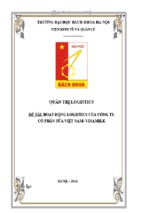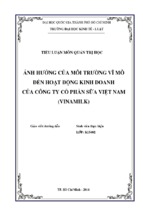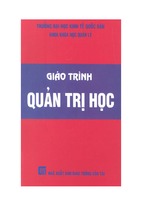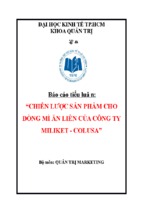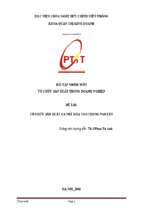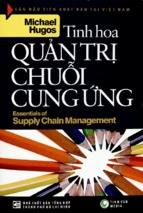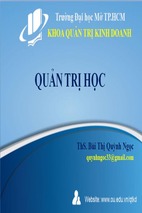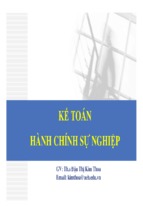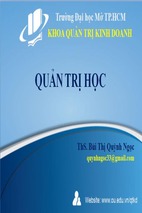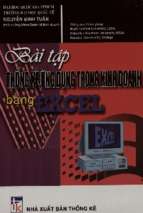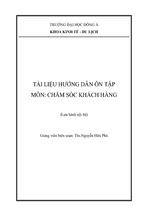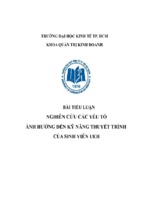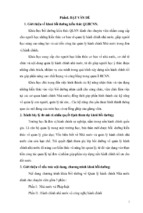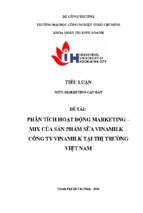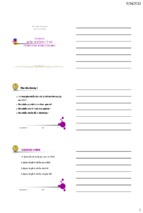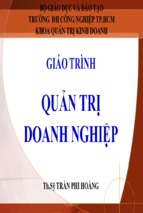22
IT ALL BEGINS WITH STRATEGY
strategy team brainstormed about how they could use the Internet to enhance each of
these mission-critical activities or carry them out more efficiently.
Strategic planning should always begin with organizational mission—the purpose
and reason for being of every nonprofit. Mission dictates the activities and programs
of an organization, both on- and offline. Mission clarifies the “business” a nonprofit
is in—that is, the scope of what an organization wants to accomplish—and strategy
determines the activities that will be used to support the mission. Some organizational
missions require promoting awareness, providing services, conducting programs, or
carrying out other activities. Properly deploying the Internet requires viewing an organization holistically, with fulfilling the mission as the paramount goal of every
activity, department, and program. Mission articulates the what; strategy provides
the how.
Additionally, every activity should be accompanied by clear, quantifiable objectives to measure the relative success of efforts, as well as to demonstrate return on investment. Developing a strategy is often the ideal time to revisit goals and objectives
to ensure they are still timely, accurate, and relevant to the mission.
CONSTITUENCY
As the strategy team brainstormed, they realized all of their ideas had one thing in
common—the involvement of the patrons, donors, volunteers, members, and other
constituents who supported the symphony. Internally, the strategy had to serve the
symphony’s mission. But, it also had to serve an external audience—the wants and
needs of the people most important to the organization.
Nonprofits must identify and respond to the wants and needs of constituents in
order to build and sustain a loyal donor base. Just as with direct mail, operational activity, marketing, or any other offline activity, Web presence must closely match constituent needs, and building an effective strategy requires knowing and understanding
the values, attitudes, and behaviors of constituents in order to tailor Web content and
services. Information must be relevant and timely, services must be useful, and the overall experience must be user-friendly and valuable. When it comes to relationship building, organizations must conduct coordinated, constituent-centric activities in order to
attract and maintain the attention and support of the public. Having a Web site that
lacks timely and interesting content or helpful services, for instance, will discourage
visitors from returning.
Of course, these elements are both interdependent and subject to change, making
strategy a living, constantly evolving process. To be effective, the use of technology
must be revisited from time to time as the activities evolve to ensure all aspects of the
organizational strategy are being supported. The impact the Internet will have on
fundraising and the nonprofit community is far from certain, and nonprofits will need
to adapt their strategy to take advantage of ever-improving technology and online
marketing practices. The process of crafting a strategy is often iterative. The results and
feedback from strategically planned activities inform and drive decision-making going
forward, a self-tuning approach that vastly increases results over time.
Applying Strategy—Sample Case
23
APPLYING STRATEGY—SAMPLE CASE
After assessing the symphony’s mission, the activities of each department and the needs
of their constituents, the team began drafting a strategy. From a strategic standpoint,
making decisions regarding the board’s suggestions was much easier.
The team recognized two primary objectives for the symphony: optimizing internal business processes and conducting bidirectional communication with constituents.
After identifying these objectives, they could focus on how to use the Internet to support, expand, and deepen the symphony’s existing mission-critical activities.
Fundraising was integral to the sustainability of the symphony’s operations and
was one of the initial reasons for investing in a Web site. Accepting online donations
would be convenient and easy to use for donors and could automate gift entry and
processing, reducing the burden of administration and freeing staff to work on more
valuable activities. Additionally, e-mail campaigns could complement the symphony’s
successful direct mail efforts. The strategy team discussed these options with the board,
and everyone agreed they should move forward with these initiatives. Although the
symphony held a silent auction fundraiser every year the team realized that online
auctions were beyond the scope of the symphony’s mission.
A significant portion of the symphony’s constituent-facing activities took place
through the ticketing department, and the Web offered a number of opportunities to
improve service and increase value to the public. Online ticketing would make attending performances more convenient, and online customer service features—including
a “Contact Us” Web form and a list of FAQs—could help the symphony better serve
patrons while reducing the number of incoming calls. These options could provide
convenient alternatives for visitors in addition to the traditional ways of contacting
the symphony.
The marketing department began a publicity drive that would take advantage of
the inherent benefits of Internet communications. They added the symphony’s Web
address to all of its printed materials to drive traffic to the site and began publishing
high-quality, Web-only content to keep site content fresh and encourage first-time visitors to return to the site. Rather than investing in more graphics and animation for
the site, the team decided to repurpose print content for the Web—an approach that
would save time and money, as well as provide an ongoing resource for people interested in the symphony and its performers. Although having online communities and
Web casts of performances were initially interesting ideas, these ideas failed to hold
up under closer strategic scrutiny. The team decided that the time and resources required to build these features would be better spent elsewhere. However, the team
agreed to reconsider these ideas in the future when revisiting their strategy.
The marketing and development teams also worked together to take advantage
of the Web for a benefit concert with the symphony’s jazz quartet at a popular
local venue. The jazz quartet had broad appeal and, historically, jazz events had
been one of the symphony’s top fundraisers. This year, the symphony wanted to
expand the event to include an even broader audience. The strategy team recognized that the Internet—with more efficient processing, 24/7 availability, and appeal
to a younger demographic—could potentially help to achieve this objective.
In order to reach a broad demographic, the symphony promoted the concert
through partnerships with local rock and popular radio stations. In addition to of-
24
IT ALL BEGINS WITH STRATEGY
fering tickets through the symphony’s traditional ticketing office, the symphony
began offering tickets online. Each radio advertisement mentioned the symphony’s
Web address and encouraged people to buy tickets and donate online. To further encourage online traffic, the symphony offered two-for-one coupons for online ticket
buyers. Additionally, demographic information from online donations and ticket purchases—including e-mail addresses—was captured and logged into the donor database for use in future e-mail campaigns.
The initial results from the benefit concert were very encouraging—the broad
appeal of the quartet combined with the reach of popular radio stations drew a record
crowd, as well as provided a great jump start for the Web site and a substantial pool
of e-mail addresses for future communications. The key to this success was the strategy team’s recognition that e-mail functionality, e-ticketing, and Web-based communication and support could not replace their traditional offline counterparts.
Executing the strategy improved the results of these activities and deepened value to
constituents—a key to any successful strategy.
CONCLUSION
The preceding case study, although fictitious, illustrates the leveraging power of the
Internet as a tool to support organizational strategy—from optimizing ticket sales and
improving the value of customer service to expanding marketing efforts and deepening constituent interaction.
Jane’s success derived from the articulation of an organizational strategy and the
subsequent implementation of appropriate goals and activities. In regard to Internet,
most organizations are little different than Jane’s, and nonprofits that want to benefit from the advantages of the Internet must first create a strategy.
ABOUT THE AUTHOR
Anthony J. Powell, CFRE, ePMT, vice president of consulting services, is responsible for Blackbaud’s 160-employee consulting and technical services division. Tony joined Blackbaud in 1998 as a fundraising system consultant and has
helped consulting services mature into one of the company’s fastest-growing
divisions.
Before joining Blackbaud, Tony spent 10 years in the nonprofit sector building his expertise in business process improvement, prospect moves management,
and major gift solicitations as a major gifts officer at the Smithsonian Institution, assistant vice president for the Greater Baltimore Medical Center Foundation, and VP and COO for The Wesbury Foundation.
Tony is a graduate of Allegheny College, where he began his fundraising
career as assistant director of the Annual Fund. A five-time CASE Faculty All
Star, Tony is a frequent speaker at national and international industry conferences. You can e-mail Tony at
[email protected].
Endnotes
25
ENDNOTES
1. Fundraising is only one way in which nonprofits can use the Web. Many nonprofits have
used the Internet to automate labor-intensive back office tasks through automatic inventory control, services management and similar tools. While constituent engagement has
been the focus of much publicity surrounding the Internet, internal optimization has historically demonstrated lasting results for both businesses and nonprofits. A discussion of
the benefits inherent to business-to-business (B2B) applications of the Internet, however,
is beyond the scope of this book.
2. Nicole Wallace, “Online Donations Make Gains,” The Chronicle of Philanthropy (June
12, 2003).
3. Nicole Wallace, “Charities Tally Year-End Online Gifts,” The Chronicle of Philanthropy
(January 21, 2003).
4. NonProfit Times study, February 17, 2004. Available online at http://www.nptimes.com/
enews/Feb04/news/news-0204_3.html.
5. www.redcross.org.
6. Nicole Wallace, “Charities Tally Year-End Online Gifts,” The Chronicle of Philanthropy
(January 21, 2003).
7. www.heifer.org.
8. Reed Abelson, “Business to Business: Charities See Web’s Potential, but Are Finding It
Hard to Afford,” The New York Times (29 March 2000), Section H, p. 30.
9. www.virtualpromise.net.
10. Blackbaud Consulting Services 2003 study.
11. Michael E. Porter, “What is Strategy?” Harvard Business Review (November–December
1996), 70.
12. Michael E. Porter, “Strategy and the Internet,” Harvard Business Review (March 2001), 64.
13. Michael E. Porter, “What Is Strategy?” Harvard Business Review (November-December
1996), 64–68.
CHAPTER
3
Multichannel Marketing
Marcelo Iñarra Iraegui, ePMT
Greenpeace International
Human beings use different kinds of thought mechanisms to understand
different kinds of situations.
MARKETING WITH A CHEF’S HELP
Think about your favorite dish for a few seconds. Ready? Now think about the ingredients that make this dish so special for you—its unique taste, the aroma and special
texture, the mixture of colors, or the sound it makes while cooking. This exercise will
surely have whetted your appetite, but restrain your desires to rush off to your favorite
restaurant. We are here to discuss how marketing will better your fundraising program by using the different offline media integrated with the online world. So let’s go
back to the kitchen. As I can’t make an analysis of your favorite dish, I’ll do so for
mine.
Spaghetti with Seafood Sauce
What makes this dish so special for me? The texture of freshly made spaghetti, the
tomato sauce with red crayfish, mixed with fresh green herbs, and the unique aroma
of chopped garlic in olive oil all produce expectations and anticipation of an unmistakable taste. This dish awakes all my senses, and this synergy of sensations
makes it my chosen dish from among hundreds. This dish naturally uses multichannel marketing.
As fundraisers, we need to use multichannel marketing to combine traditional
media with the Internet, just as a chef mixes ingredients with artistic flair and knowledge to create our favorite dish.
Multichannel marketing grew on a worldwide scale in the commercial sector during the 1990s, but without a doubt, this great revolution is a result of the incorporation of the Internet as a channel that modified the way of understanding and doing
business. Today, it seems impossible for a company not to plan a sales campaign in
an integrated online/offline way, whether we are talking about a mass consumer product such as soap powder, or a luxury item such as the most expensive car in the world.
This is a tremendous opportunity for the nonprofit sector, because there aren’t many
26
27
A Chef in a Virgin Land
such organizations using the mass media or more segmented media such as direct
mailing or telephone fundraising with an online component.
A CHEF IN A VIRGIN LAND
I started as fundraising director for Greenpeace Argentina in 1995. Argentina was
then an almost virgin market in professional fundraising, with all the advantages,
challenges, and inconveniences that a new market presents. Instead of copying the established models, we ran multiple tests to find out which was the most appropriate
form of media for Greenpeace Argentina. We incorporated integration of online
media in 1996. We had our first donor through our Web page www.greenpeace.org.ar
in the same year. Our Web site has subsequently transformed itself into a response
channel whereby a third of new donors join Greenpeace Argentina (see Exhibit 3.1).
The Greenpeace Argentina case began to be published and presented in the main
international conferences, without our seeking this out, because of the diverse and
successful strategies we have been working with since the middle of the 1990s.
Following Jules Verne’s thought that “by knowing your village you will know
the world,” we systemized the general teachings of the “Seven Elastic Rules of Online Fundraising”:
Percent of All New Monthly Supporters
1. Change organizational culture, or how to make bytes an integral part of your
existence.
2. Use the Web site as a response channel.
3. Develop a strong e-mail fundraising program.
35
32
30
28
25
22
19
20
15
10
7
5
3
1.4
0
1997
1998
1999
2000
Year
EXHIBIT 3.1
Evolution of Online Donors
Source: Greenpeace.org.ar
2001
2002
2003
28
MULTICHANNEL MARKETING
4. Integrate online and offline media.
5. Communicate from your Web site the opportunity to “live” the experience of
being part of your organization.
6. Use online media to foster the relationship with donors.
7. Test. The history of online fundraising is being written and boundless discoveries are there to be made.
In this chapter, we shall be looking in detail at some of these rules, relevant to
the theme of this chapter.
KNOCKING DOWN WALLS
Human beings use different kinds of thought mechanisms to understand different kinds
of situations. One such mechanism is separating a complex problem into its distinctive parts in order to understand them. By analyzing these parts, we can understand the
whole.
As fundraisers, we often propose strategies that employ this thought mechanism,
but sometimes we get stuck in the middle of this process without reintegrating each
component into the whole. This is one of the consequences of how some organizations
structure their fundraising department, somewhat like a silo. They have an area of direct mail, another of telemarketing, another of major donors and yet another of bequests, and there is a very low level of integration between the divisions.
This management structure was carried into fundraising, using only one medium,
without at least testing the different integration possibilities with one or more media.
The Internet has done more than just knocked on fundraising’s door, however; it has
the tools to demolish walls!
The online strategy is a transversal component that cuts across all areas and
poses a big challenge to these areas. A challenge that is even more complex in big organizations where structures are more specialized resulting in more isolation.
The solution to these problems is varied and different for each organization. The
important thing is to knock down these walls, and the entire team must share the
same motivation to reach a common goal.
Integrating Traditional Media with Online Media
Integrating the Internet into the fundraising strategy has to happen in the fundraiser’s
head. This integration has more to do with a change of attitude toward using online
media than massive investment of resources. It is fundamental to break down resistance, such as “This won’t work,” “It’s not for us,” “Things are different in our country,” and many other barriers and fears, too numerous to mention here.
There are hundreds of reasons in this book, backed up with solid arguments and
evidence, that prove that the Internet has arrived in the world of philanthropy to
stay. Strategically, the integration of offline media with the Internet involves two big
components:
1. Using the Web site as a channel where donors respond to campaigns
2. Providing the opportunity to consolidate the reasons why people should support
our organization, and acting as the point of “closing” for appeals
29
Knocking Down Walls
Going in through the Screen
To be able to use your Web site as a response channel, it is advisable to ask yourself
some questions:
How would I respond to being asked for a donation?
What channel would I use to respond?
Would I prefer to respond by telephone?
Would I prefer to send a fax?
Would I like to fill in a coupon to be sent by mail?
Would I want to make my donation online using a Web site?
In my experience of working on a global level, from the 1990s up to now, having
contact with fundraising professionals from all over the world, I have seen a strong
and growing trend in the use of online media as a response channel.
In fundraising programs where a choice of options to make donation is given, including online, there has been a significant increase in the number of people who respond via the Internet, in detriment to traditional channels, such as by post, fax, or
telephone.
This trend will continue to rise over the next several years. Demographic changes
have shifted the power to kids—who are practically born with a PC in their crib. These
will be the core targets of most organizations (see Exhibit 3.2).
Responders Evolution 1990s
Phone-fax-post
responders
Online
responders
Responders Evolution Today
Phone-fax-post
responders
EXHIBIT 3.2
Tracking Core Targets
Source: Greenpeace Argentina
Online
responders
30
MULTICHANNEL MARKETING
Let’s analyze a case from a quantitative point of view.
In Greenpeace Argentina’s January 2000 multimedia campaign (see Exhibit 3.3)
against whaling in the Antarctic, 25 percent of total supporters who responded preferred to make their donation via our Web site, even though our messages were transmitted from various offline media such as television, radio, billboards, and press ads,
among others. Thus, 75 percent of donors responded through offline channels, such
as telephone, fax, or mail.
The results obtained in that campaign has established guidelines and standards
that are still used today. Some results obtained were as follows: 21 percent of total
donors who saw a 36-second television spot preferred to join through our Web site,
and the most surprising, 34 percent of donors who heard our message by radio joined
via the Web site.
Let’s analyze this campaign from the viewpoint of online donors. What media had
more influence on these donors? Was it the offline ones, such as a 36-second TV spot,
newspapers, magazine and posters advertisement, those by radio, or the online ones
with an intensive banner campaign in the main portals? Which ones would you bet
on? If you bet on the offlines—then you’ve won. Of total online donors, 67 percent had
seen our appeal for donation through the offline medias. The other 33 percent responded to our intensive banner and article campaign with Web site links. This is not
a surprising result given that we spend most of our lives living our “material world”
offline.
Let’s look at what these online donors thought about their online experience.
From a qualitative point of view, it is interesting to note the comments of some of these
donors, who later formed part of a focus group on satisfaction. Some of their com-
APPEAL
EXHIBIT 3.3
Response Channel %
Online
Offline
TV spot
Web + Portals + Banners
Press ads
Radio
Billboards
PR
Newspapers and magazine inside
Inserts
Free postcards
Spontaneous
21
73
17
34
26
17
62
16
5
0
79
27
83
66
74
83
38
84
95
100
TOTAL
25
75
Whaling Campaign 2000—General Results
Source: Greenpeace Argentina
Knocking Down Walls
31
ments, in relation to the response channel, were surprising: “It is so easy, you just fill
in the form on the site and you donate right away.” “It was the only way to join. If
it hadn’t been so simple, I would have never joined.”
This research proves that they would not have made their donations if there hadn’t been the option of donating via our Web site. This result is also backed up by our
daily experience in our Supporter Service Area.
Another fundamental reason to integrate your Web site as a response channel is
that it allows you to attend to hundreds of requests per second. This makes any campaign that uses a mass-media strategy such as DRTV—Direct Response Television—
a natural partner to online response mechanisms.
Television spots generate a huge volume of “calls/hits/requests” in the first few
seconds of an appeal, be this a 60-second spot or a telethon of various hours. People
respond impulsively and immediately. A Web site allows you to process a volume of
transaction that is impossible for any traditional call center to attend to in the same
space and time.
The UK Comic Relief Case, www.comicrelief.com shows that in their 2002 yearly
telethon, they succeeded in processing 47,000 online transactions between 9:30 P.M.
and 10:30 P.M.
That is 783 per minute!
Using your Web site as a response channel, when responding to offline medias,
also has other fundamental attributes. It is open 24 hours, 365 days a year. This advantage was fully utilized in a 2003 Pan Regional Greenpeace International campaign
covering 23 Latin American countries, that I ran, combining the use of satellite television and the Internet as the response channels, running a series of messages on a rotative basis, covering the different time zones and effective use of nighttime and early
hours.
One remarkable fact is that online donations have a higher average than those
made offline. In the case of one-off gifts, online donations have been 50 percent more
than offline, as in the September 2001 Telethon case, “America: tribute to heroes,”
where average offline gifts were $100 (U.S. dollars), while online gifts were $150.
In my experience of working with monthly and automatic donations, online donations are between 10 percent and 20 percent more than offline.
Welcome to . . .
The second strategic component in the integration of media is the possibility to consolidate the reasons why people should support our organization. Our Web site has
the job of “closing” our offline request.
The Internet offers tools that fundraisers have dreamed about: to be able to penetrate the mind, inspire, and seduce people into how worthy it is to support our cause.
A Web site can use almost all the creative resources of other mass media, amply surpassing their normal effectiveness when used interactively.
Let’s look at some examples: A direct-mail pack can be made more powerful by
being combined with an unforgettable online experience. The contents of a press ad,
or a radio or television spot can be amplified to a degree that is impossible to communicate on a page or otherwise in a few seconds.
There is also one vital point to be noted. A Web site offers the chance to start a dialogue that can last for life. If we invite visitors to the site to leave their e-mail address,


